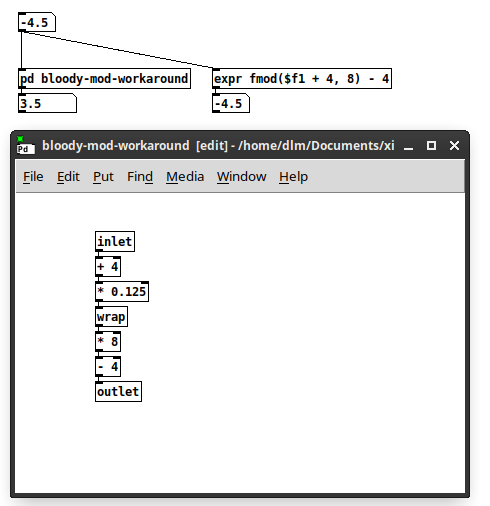-
ddw_music
posted in technical issues • read more@solipp said:
use [set 64 1 $1(
no need to switch dsp offThanks -- in the reference, I saw "<list>" but I missed the "set" before it. Good catch.
Yeah, it's working now!
hjh
-
ddw_music
posted in technical issues • read moreI was writing up a quick demo of oversampling, and found to my surprise that [block~] seems to be ignoring messages. I've got a toggle going into the subpatch, [inlet] --> [* 7] --> [+ 1] --> "64 1 $1" --> [block~], and when I flip the toggle, there's no difference in the sound.
I even tried switching dsp off and on again, but no dice.
Are messages to [block~] supposed to work? Or, should they be sent only when dsp is already off?
Here's another version of the patch that switches DSP off, sends the block~ message, then switches back on. I don't hear it doing anything. OK, worst case I'll just have two oscillators and switch them at the output, but the block~ help patch documents that a message can be used and AFAICS it doesn't work.
TIA,
hjh -
ddw_music
posted in technical issues • read more@Moddmo said:
I guess a better question is if pd has disadvantages here compared to other DSP programming languages.
Granular synthesis is sometimes imagined as this magical, complex thing, but the fundamentals are quite simple. Get the fundamentals right, and the sound quality follows from that (and is mainly a matter of parameter tuning).
So you're playing back a block of audio from a buffer or a delay line. (I used a delay line because that's the best way to implement a circular buffer in Pd vanilla. You could also use cyclone [count~] to generate phase for use with [tabwrite~] and [tabread4~].) The important points here are to get the boundaries of the audio segment correct, and to modulate the starting position intelligently. "Boundaries" includes concepts of: how many grains per second should be triggered, how many of them overlap, how fast will the audio be played.
And each grain needs an envelope matching the grain duration.
In my example, I've already tuned it for one specific use case (pitch shifting). But there's no magic here -- it really is just linear audio playback with envelopes, overlapped and added.
Comparison with other DSP environments, then, is just a matter of implementation. E.g., SuperCollider has UGens (single objects) TGrains and GrainBuf that do the audio segment and envelope and overlap/add for you, so that you can concentrate on the parameters:
s.boot; // sort of like "; pd dsp 1" ( var rateSl; a = { |inbus, rate = 1, trigFreq = 66.66667, overlap = 4| var sr = SampleRate.ir; var maxDelaySamps = 2 * sr; var src = In.ar(inbus, 1); // "delwrite" part (rolling my own circular buffer) var buf = LocalBuf(maxDelaySamps, 1).clear; var phase = Phasor.ar(0, 1, 0, maxDelaySamps); var writer = BufWr.ar(src, buf, phase); // *all* of the rest of it var trig = Impulse.ar(trigFreq); var grainDur = overlap / trigFreq; var delayBound = max(0, grainDur * (rate - 1)); // grain position in samples, for now var pos = phase - (sr * (delayBound + TRand.ar(0.0, 0.003, trig))); GrainBuf.ar(2, trig, grainDur, buf, rate, pos: (pos / maxDelaySamps) % 1.0, // normalized pos in GrainBuf interp: 4 // cubic ) * 0.4; }.play(args: [inbus: s.options.numOutputBusChannels]); rateSl = Slider(nil, Rect(800, 200, 200, 50)) .value_(0.5) .orientation_(\horizontal) .action_({ |view| a.set(\rate, view.value.linexp(0, 1, 0.25, 4)) }) .onClose_({ a.free }) .front )The DSP design here is the same as in the Pd patch (rate-scaled audio segments under Hann windows [GrainBuf gives you Hann windows for free], with a 3 ms randomized timing offset for each grain) so the sound should be basically identical. Personally I find the SC way to be easier to read and write, but I wouldn't expect everyone on a graphical patching forum to feel the same

hjh
-
ddw_music
posted in technical issues • read moreOK, here's a basic live input granulator, no really fancy features, just pitch shifting.
The handling of grain playback rate in the one-grain abstraction is a neat trick I had worked out some time ago. For example, if you want to play the grain an octave higher (2x speed), then you need to span
2 * durms of audio indurms of time. You can do that by modulating the delay time as a straight line, fromdurms to 0 ms -- addingdurto the delay time at the beginning adds that many ms to the amount of audio being used:dur * (rate-1). Or, to play slower, start with a shorter delay and go toward a longer delay, and the boundary is againdur * (rate-1). If rate = 1, then the delay time goes from 0 to 0 = no change = normal speed. That might look a bit funky in the patch you can try it with different transposition intervals, which will show that it's correct.For sound file processing, replace the delay line with a soundfiler-filled array, and use tabread4~ for the audio source (and the line~ driving it will have to be different too).
IMO granular processing is 99% refinement and more advanced modulation of these basic parameters, which you should be able to tailor to your needs. I think the pitch shifting is more-or-less smooth here, though I'm not sure it matches your comparison plugins -- this is 66.6667 grains per second, with 4x overlap.
one-delay-grain.pd
live-granular.pdhjh
-
ddw_music
posted in technical issues • read more@Moddmo said:
I don't want to spend months making a patch and end up with crap sound.
Well, that's hard to promise because I'm not sure exactly what you mean by crap sound.

What I can say is that granular synthesis is made up of short clips of audio under envelopes. Pd can do both:
- clips:
tabread4~for a sound file loaded into memory,delread4~for live input. - envelopes: you can fill an array with a Hann (or any other type of) window, and stream it out using
tabread4~as well.
Pd has one edge over Max here, in that Pd's
metrois sub-block accurate. In both Pd and Max, there's an audio block size (default 64 samples), and control messages execute only on those block boundaries. In Max, last time I tried to do granular synthesis driven by control messages, I could hear the timing inaccuracy due to the messages being quantized to these block boundaries. (Maybe that's changed in Max 9, but that's my recollection from Max 8.) In Pd, control messages are processed on block boundaries, but they also carry sub-block timing information so that grains will start on the right sample, not just the right block. IMO Pd's timing was noticeably smoother. (In Max, multichannel signals get a better result.)For sound quality, it's very helpful to introduce a little bit of randomness into the grain time position, to avoid "machine gun" effects.
Again, "close to the available software," I'm not sure exactly what you mean. With proper tuning, I was able to get a pretty smooth sound out of it. Maybe an example later.
hjh
- clips:
-
ddw_music
posted in technical issues • read more@jamcultur said:
If the code on Windows was the same as the code on Mac, they would work the same.
One source of confusion here is the difference between source and object code.
Most of the time, humans never look at the object code produced by a compiler. We only look at the source code. So, when porres says there's no difference in the code between platforms, this is talking about source code.
The source code gets compiled into object code. In Mac vs Windows, the compilers are different, and the CPUs (architectures and instruction sets) are different. If the Mac is using an M-series CPU, then it's impossible for the object code to be the same as Windows (Intel or AMD chip), because the instruction sets are completely different. (That's also not considering the differences in OS function calls, which of course will not be the same between different OSes.) So in fact, "the code" isn't the same -- but this isn't porres's fault, and there's no way for the code not to be different.
Ideally, the same source code compiled for different chips should produce equivalent results. Programmers usually take this as a safe assumption. But there are edge cases where it might not work out that way (we just saw one of those over in SC-land, related to floating-point rounding). These cases can be extremely difficult to debug, and at the end of the day, one is at the mercy of the CPU and the compiler's behavior.
In such cases, it isn't helpful to accuse a developer of writing different code for Windows (this is implausible for DSP code in any case, which is mostly math operations that are well abstracted -- you don't need #ifdefs for std::xxx() math functions) or of "not caring" enough.
We want to assume that the compiler and CPU are transparent with respect to the source code's meaning. When that isn't the case, it's necessary to inspect every operation. It's painful, and if porres doesn't have access to a machine where the problem occurs, it can be very slow (test builds, relying on other people to run the specific tests). A little patience goes a long way.
hjh
-
ddw_music
posted in technical issues • read more@porres said:
cyclone does not have a [spectrogram~] object
ELSE has [spectrograpg~] though.
Thanks -- I didn't look closely enough at the help patch.
About formant synthesis with FM, I know Miller includes something like that in the audio examples (see F10). Is it related maybe?
It probably is, and his implementation is probably more elegant than mine (though it's jammed into a small space on the screen so it's a bit tough for me to read quickly).
It takes some tuning -- the FM index isn't a simple analog to formant bandwidth (it seems to need to be scaled down at higher pitches). But it's computationally cheap and gets a useful result, and it seemed to fit "approaches to formants other than bandpass filtering."
hjh
-
ddw_music
posted in technical issues • read moreThere's also the John Chowning "Phoné" FM formant approach, where the carrier is at the formant center frequency and the modulator is at the fundamental. It's "formant-ish" I suppose, but sweeping the fundamental while holding the formant frequency steady does produce a vocal-ish sound.
Here I'm crossfading between two formants, to make smooth transitions between integer carrier-mod frequency ratios.
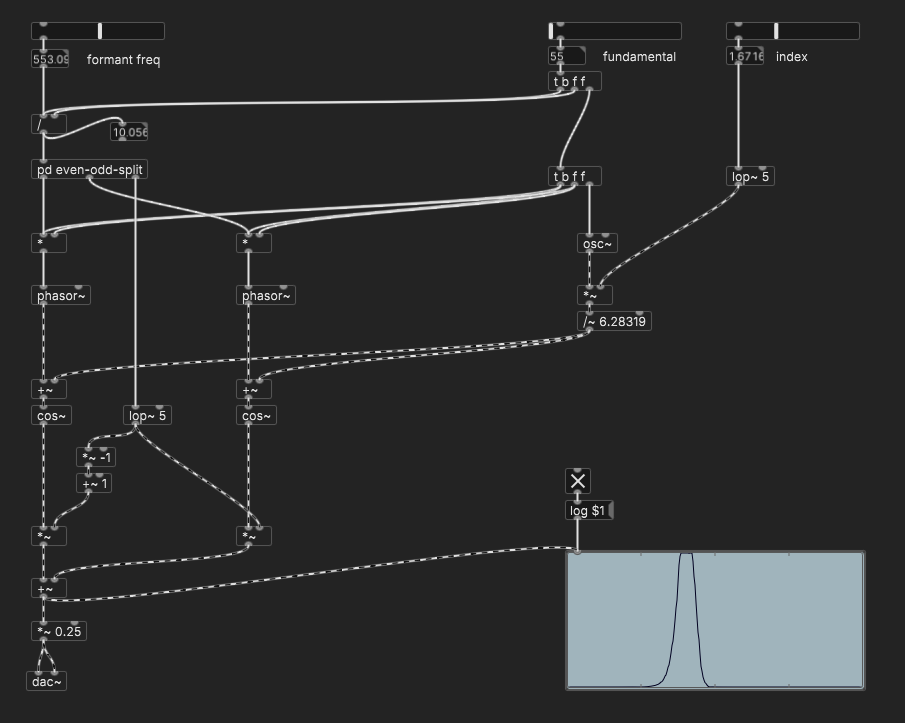
Oops, no:
(~[spectrogram~] is from cyclone -- not essential to the patch's operation.)(~[spectrograph~] is from ELSE -- not essential to the patch's operation.)
hjh
-
ddw_music
posted in technical issues • read more@willblackhurst Tilde objects don't have anything to do with voltage inside the computer.
hjh
-
ddw_music
posted in technical issues • read moreInteresting that both responses assumed that atux wants to send pitch bend messages out, but "modulate the pitch in real time by moving a slider" says nothing about MIDI being the target.
The question might just as easily be, "How to map a slider onto a frequency ratio, to multiply with the note's main frequency?"
Normalize the slider value. Because pitch bend normally goes both up and down, I normalize to -1 .. +1.
line~ for smoothing. (Also, I'm stealing the mouse-release logic from porres, good tip!)
Pitch bend range is given in semitones. We need a fraction of an octave = pbrange / 12.
Scale the normalized pb value onto the fraction of the octave = [*~].
The ratio for one octave = 2. So, the ratio for the fraction of the octave = 2 ^ fraction.
Now you have a ratio that you can multiply by any frequency, and get pb.
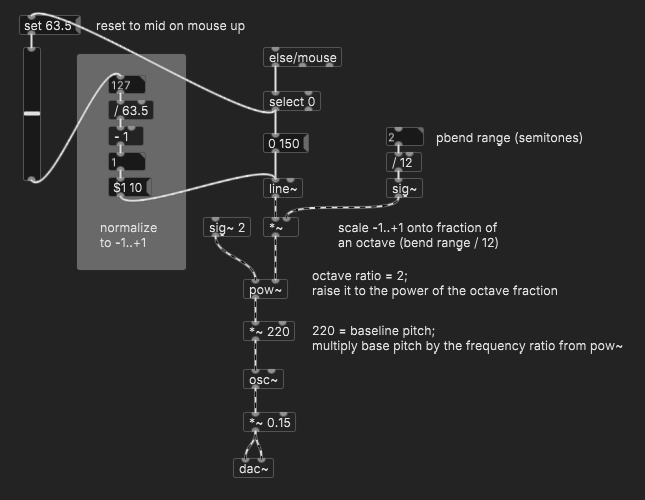
(More generally, almost any kind of exponential modulation i.e. frequency can be expressed as
baselineValue * (modRatio ** modulator). Pitch bend is a specific case of this, where modRatio = 2 and the modulator is scaled to the range +-pbrange / 12. Linear modulation just demotes the math ops:baselineValue + (modFactor * modulator). With these 2 formulas you can handle a large majority of modulation scenarios.)hjh
-
ddw_music
posted in technical issues • read more@fer FWIW this is a formula I've used for abstraction init defaults for awhile now -- only vanilla objects, no externals needed.

If the usage of the object is [defaults-test] with no args specified, it prints
abstraction_defaults: list default symbols 0 1 2 3= the values that I put into the [pack].If it's [defaults-test xyz ttt 34 72], then it prints
abstraction_defaults: list xyz ttt 34 72 2 3where the 4 values overwrote the [pack] values from the start... generally what you'd assume from defaults.(If all the args are numbers, then you don't need any funny business, just [pdcontrol] --> [pack].)
hjh
-
ddw_music
posted in technical issues • read moreyou did spread misinformation about it
So just correct it and move on.
When people try to reinvent what already exists... I built this for the community. Ignoring existing tools and efforts misses the spirit of open source
Both Pd and SC have a systemic problem wherein there is no good way for new users to know which extensions exist. Recent versions of Deken improve the situation somewhat for Pd, and there's a similar effort underway for SC, but "missing the spirit of open source" is quite a burden to lay on somebody who might have using the tool for just a couple of weeks or months.
So I'm out of this thread. I like a lot of the stuff in else, really, and I wish I'd known about it from the start. (Btw "when it's there in plugdata already" -- when I started using Pd in classes, there was no plugdata and there was no pd-extended, and no way to discover ELSE by chance.)
hjh
-
ddw_music
posted in technical issues • read more@porres said:
nah, I'll just leave as it is, the object is already too much complicated and I don't know how to deal with it (if anyone has a suggestion, please let me know).
Maybe like this? Instead of velocity --> envelope, derive a gate by way of [change]. Then multiply the envelope by the velocity value. The volume will change if the velocity changes on a slurred note. If you don't want that, it should be possible to close the spigot when slurring to a note, and open it only when a brand-new note is being played.

hjh
-
ddw_music
posted in technical issues • read more@porres said:
As for the discussion, if my objects are not working as expected, or if you have suggestions, you can open reports and requests.
OK, sure.
FWIW, I had developed my own methodology for this some years ago. At that time, I didn't know that [else/mono] existed.
I was just sharing a way to handle this problem that worked for me. My intention wasn't to raise shortcomings with your library -- it was only, "this is how I do it."
hjh
-
ddw_music
posted in technical issues • read more@porres said:
well, [else/mono] has a built-in portamento... and I don;t know what is wrong with it or how it works with [else/adsr~] for you...
I'm also sensing an unnecessarily punchy tone here. I won't engage with this.
hjh
-
ddw_music
posted in technical issues • read more@leonardopiuu said:
I began using plugdata a couple days ago and I'm making a simple mono synth
Mono synths are not simple! lol
MIDI's way of representing keyboard activity is not exactly convenient for mono use. So, I'm going to guess that the velocity and/or ADSR behavior is the result of a logic problem before reaching the ADSR.
Especially based on this comment: "BUT the velocity isn't sent out from the pack unless I press at least TWO keys at the same time..."
It's tricky. This was my solution, in the midimonoglide.pd abstraction:
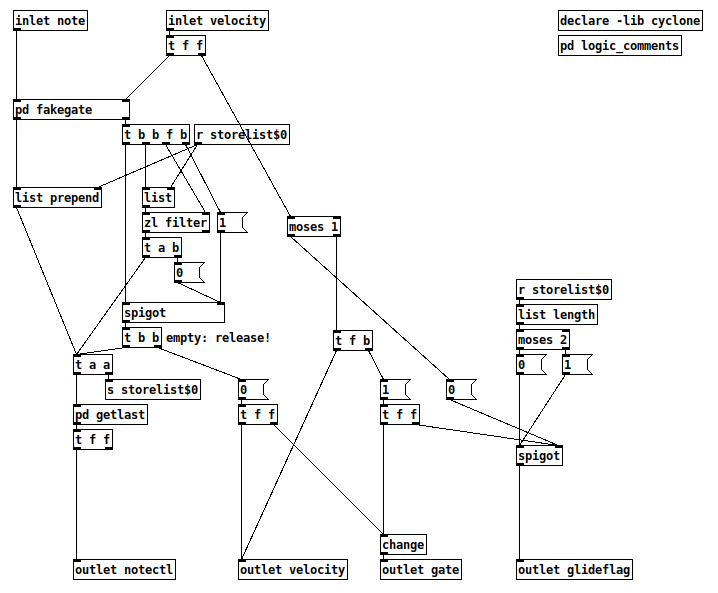
Confused? Yeah. MIDI-to-mono logic is complicated enough that it will probably take you more than a couple of days of plugdata usage to really grasp it. There's no such thing as a "simple MIDI mono synth."
So I'd suggest to use either [else/mono] -- you already have ELSE lib, so, nothing else to install -- or my abstraction (which helps with mono note glide -- but you might not need that at this point.
Then, when you have properly cleaned up and filtered MIDI data, then the ADSR "should" be the easy part.
The ELSE way -- note here that every note-on sends out a non-zero velocity, so the envelope will retrigger repeatedly. I'm not crazy about that behavior, but it might be OK for your use case (and the patch is simpler).
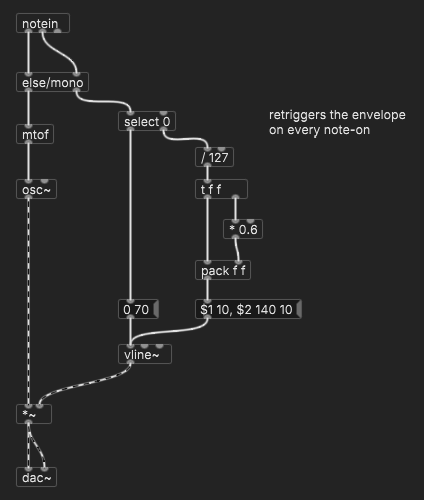
The hjh way -- where it becomes possible to distinguish between sliding, non-retriggering notes and genuinely new notes. (The [noteglide] isn't strictly necessary -- but, IMO fingered portamento is the whole point of a MIDI monosynth
 so I'm using it.)
so I'm using it.)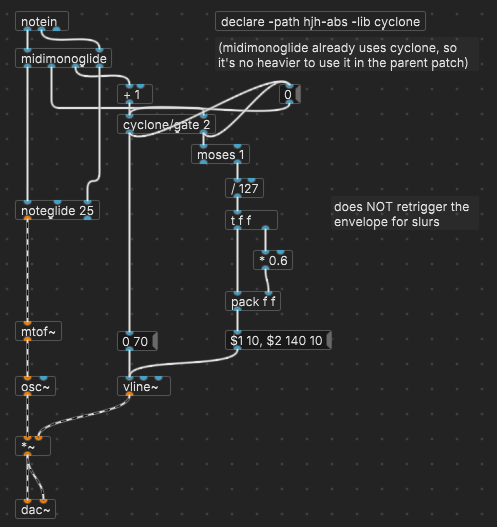
Hope this helps -- and no worries. If you made this much progress in Pd in a couple days, to the point where you run into the not-at-all obvious subtleties of MIDI mono handling, that's pretty good.
hjh
-
ddw_music
posted in output~ • read moreFinally posted video from my electronic ensemble class's concert last June. Pd didn't figure into the audio side, but 2 out of 3 pieces used Gem for the graphical backdrop.
It was a fun night, hope you enjoy!
Link goes directly to the third piece; the playlist includes the other two.
hjh
-
ddw_music
posted in output~ • read moreHere's a short clip of an interactive installation piece (I guess more of a prototype?) that was shown last weekend.
- Audio: SuperCollider (+ VSTPlugin for the piano and guzheng)
- Graphics: Pure Data + Gem
- UI: Open Stage Control (with heavy CSS gradient abuse
 -- iPad batteries really don't like rendering 13-14 new gradients, 9 times per second)
-- iPad batteries really don't like rendering 13-14 new gradients, 9 times per second)
Musical decisions are made by flipping bits in a 40-bit word, and mapping various segments of the bits onto sequencing parameters.
At some point, I'd like to do an explainer video, but not today.
hjh
-
-
ddw_music
posted in technical issues • read more@jameslo said:
@whale-av My issue is (was?) that there are things that affect the DSP sort order that you can't see from the graphics alone. As far as I understand, that's different from @ddw_music's question, which is "how much of the DSP graph does Pd have to resort when there's a change"? That said, I don't understand the reason that @spacechild1 gave on the mailing list--I'd love to see an example.
Well, here's what he said: "The issue is that DSP objects can be 'connected' by other means. Take the delay objects, for example. Some of these objects need to be aware of the order of execution within the DSP graph. Others will affect other objects, e.g. automatically changing the channel count. Pd itself doesn't know what a particular ugen is doing, so the only thing it can do is rebuild the whole graph."
@whale-av Yes, I'm writing a paper, but the paper isn't about Pd graph sorting -- this is a side point -- the latency thread is interesting but would be way too much detail for basically a footnote.
hjh

